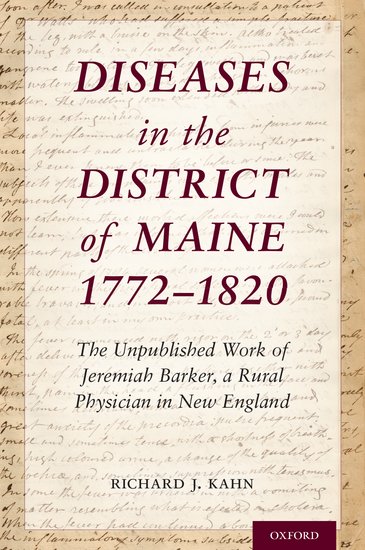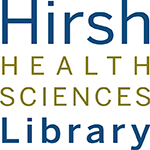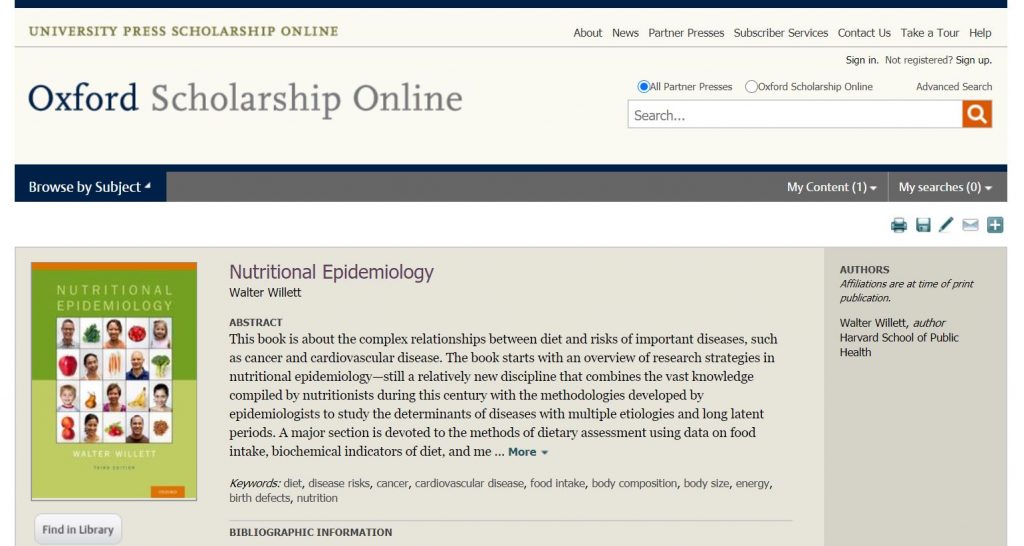Diseases in the District of Maine 1772 to 1820

https://global.oup.com/academic/product/diseases-in-the-district-of-maine-1772—1820-9780190053253?cc=us&lang=en&
A recent and notable addition to our collection is this book of medical history, written and gifted to the library by Dr. Richard J. Kahn, graduate of Tufts Medical School, m1966. Dr. Kahn has also been professor to Tufts students for most of 50 years, now through the Tufts/Maine Medical program. Below he provides a summary of the book and its contents:
“This is the story of a lost manuscript, an unpublished book written 200 years ago by a rural New England physician, who lived and practiced in Gorham and Portland, ME. It will be an important new primary source for medical history, research, and teaching for scholars and will also be of interest to general readers for, as Barker wrote on title page, it was ‘Written so as to be intelligible to those who are destitute of Medical Science.’ My introductory chapters have kept Barker’s goal, to be accessible to the general reader, in mind.
The Jeremiah Barker Papers consist of two manuscript boxes containing letters, casebooks, and several texts with marginalia by Barker, in addition to his unpublished manuscript. It is a fifty-year record of his reflections on diseases, epidemics, diagnoses, treatments, and outcomes, with an unusual effort to consult and cite the medical literature and other physicians in a changing medical landscape, as practice and authority shifted from historical to scientific methods. In short, it is a remarkable record of medicine as practiced in northern New England over 200 years ago, during the shift of medical authority from Hippocrates and Galen to the beginnings of the scientific method.
The publication of Barker’s manuscript, fully annotated, includes my five-chapter introduction, that is a sketch of Barker’s background, education, and writings, the difficulty in obtaining the medical literature through books, journals, newspapers, and the post, and a chapter contextualizing the changing medical climate as science supplanted the words of Hippocrates and Galen. One chapter examines Barker as a ‘dangerous innovator’ experimenting with the new chemistry of Lavoisier. The final chapter suggests ways for the general reader to approach a 200-year-old manuscript, avoiding ‘presentism,’ the post hoc fallacy, and confirmation bias. A glossary will define and explain terms and medications not commonly used in the 21st century.”
You can find Diseases in the District of Maine 1772 to 1820 on the 4th floor of the library at the New Books display.
Nutrition: New eBooks
Hello everyone!
We hope you are well, staying safe, and healthy out there. Below is another set of newly acquired electronic books that are now ready for use. This list focuses on Nutrition reserve titles. Please take notice of the Public Notes that are under the platform link in JumboSearch, as they will provide you with important access information.
- NUTRITIONAL EPIDEMIOLOGY
- OBESITY EPIDEMIOLOGY
- PLANNING HEALTH PROMOTION PROGRAMS: AN INTERVENTION MAPPING APPROACH
- FOOD ACTIVISM: AGENCY, DEMOCRACY AND ECONOMY
- HANDBOOK OF FOOD AND ANTHROPOLOGY
- MASS STARVATION: THE HISTORY AND FUTURE OF FAMINE
- AID IN DANGER: THE PERILS AND PROMISE OF HUMANITARIANISM
- NEW FAMINES: WHY FAMINES PERSIST IN AN ERA OF GLOBALIZATION
- ASKING QUESTIONS: THE DEFINITIVE GUIDE TO QUESTIONNAIRE DESIGN
- EXPERIENCING FIELDWORK: AN INSIDE VIEW OF QUALITATIVE RESEARCH
- POVERTY AND FAMINES: AN ESSAY ON ENTITLEMENT AND DEPRIVATION
- POWER OF POSITIVE DEVIANCE: HOW UNLIKELY INNOVATORS SOLVE THE WORLD’S TOUGHEST PROBLEMS
- RESEARCH METHODS IN ANTHROPOLOGY: QUALITATIVE AND QUANTITATIVE APPROACHES
- SHAPING THE HUMANITARIAN WORLD
- SOCIAL AND CULTURAL ANTHROPOLOGY: A VERY SHORT INTRODUCTION
- STATISTICS AT SQUARE ONE
- STATISTICS AT SQUARE TWO: UNDERSTANDING MODERN STATISTICAL APPLICATIONS IN MEDICINE
- WAR & CONFLICT IN AFRICA
EVERYONE SMILES!
February is upon us and in honor of National Children’s Dental Health Month and Black History Month, we bring you EVERYONE SMILES! co-authored by Tufts University’s own School of Dental Medicine student Gary L. Kersey. The book showcases the diversity of smiles and takes children through a step-by-step guide on brushing, flossing, and rinsing. From a historic standpoint Gary L. Kersey is the first and youngest African-American to publish a book of this kind.
Advocating that the power of the smile touches each and every culture around the globe, in addition to the easy-to-learn dental health lesson for kids, this book includes pediatric diversity in the form of age, race, gender and both mental and physical disabilities. – Ambassador International Publishing
Gary L. Kersey - photo: Tim J. Kim (TUSDM '18)
“Everyone Smiles hits the literary market at a time when lack of access to affordable dental care, is causing residual effects and detrimental impacts on the general health of low-income Americans, especially in children. Tooth decay is the most common chronic illness among school-age children, yet it is almost entirely preventable. Furthermore, the rate among low-income children is more than twice that for children with more income (31% versus 14%). Ironically, Medicaid and CHIP cover comprehensive dental benefits for children, but 30% of children with private health insurance are uninsured for dental care. (These dental statistics are sourced from the Kaiser Family Foundation).” – Gary L. Kersey, Jr.
A copy of EVERYONE SMILES! can be found at the new books display on the 4th floor of the Sackler Building.
Recent Posts
Categories
- 4th Floor Tabling (3)
- affiliation (4)
- Announcements (353)
- Book/Resource Reviews (117)
- Hours (131)
- Interviews (4)
- New Titles & Resources (114)
- News & Events (266)
- Open Workshops (48)
- Outside News & Events (66)
- resources (18)
- throwback thursday (5)
- Tips & Tricks (135)
- Uncategorized (148)
Tags
4th floor affiliation books Boston circulation crafts electronic resource electronic resources events exams extended hours food fun fun lab funlab graduation HHSL Hirsh Health Sciences Library holiday holiday hours holidays hours leisure reading library fun lab library service desk library staff new books open access open access week open workshop Open Workshops reserves resources staff statistics summer survey tea Thanksgiving therapy dogs Tufts Hirsh Health Sciences Library website welcome! writing consultants writing helpFollow us @TuftsHHSL!
Twitter feed is not available at the moment.








